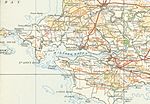East and West Blockhouses
Archaeological sites in PembrokeshireBlockhousesBuildings and structures in Milford HavenDevice FortsForts in Pembrokeshire ... and 2 more
History of PembrokeshireRuins in Wales

The East and West Blockhouses were Device Forts built by King Henry VIII in 1539 to protect the harbour of Milford Haven in Wales. The two blockhouses were positioned on either side of the Milford Haven Waterway in the villages of Angle and Dale respectively, overlooking the sea. The East Blockhouse was never completed, but the remains were reused as a defensive site in the Second World War. The West Blockhouse was described by contemporaries as forming a round tower with gunports, but it was demolished when West Blockhouse Fort was built on the same site in the 19th century.
Excerpt from the Wikipedia article East and West Blockhouses (License: CC BY-SA 3.0, Authors, Images).East and West Blockhouses
Angle Road,
Geographical coordinates (GPS) Address Nearby Places Show on map
Geographical coordinates (GPS)
| Latitude | Longitude |
|---|---|
| N 51.68213 ° | E -5.12424 ° |
Address
Angle Road
SA71 5BA , Angle
Wales, United Kingdom
Open on Google Maps










